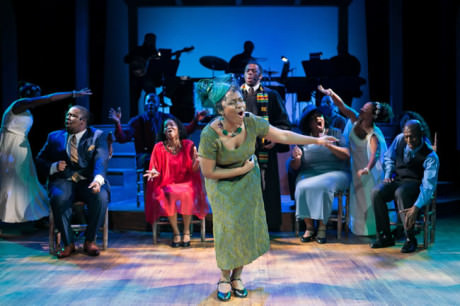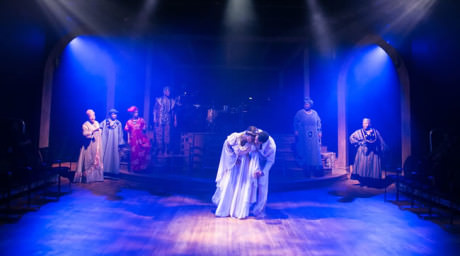If it is true that theater originated as worship and ritual—as a healing form of human communion with sacred mystery—then that history is surely raising the rafters of the Anacostia Playhouse these days. The joyous occasion is the return of Theater Alliance’s acclaimed Black Nativity, Langston Hughes’ poetic “song play” based on Gospel narratives of the birth of Jesus.

I missed seeing the 2014 production. When the show garnered eleven Helen Hayes Award nominations and won three, I remember asking myself, What was I thinking? This year I got a second chance. Black Nativity is more magnificent musically and more beautiful and more powerful than I could possibly have imagined.
Last year my DCMetroTheaterArts colleague Ramona Harper wrote an exultant rave about Theater Alliance’s first mounting of Black Nativity and called it “a gloriously joyful noise…an Afrocentric celebration of the Christmas story rooted in the strength and power of the African Diaspora…a jubilant holiday classic and unforgettable theatrical experience.” I reread her inimitably eloquent review after seeing the show for myself—and every word of it sings true.
Black Nativity, Harper wrote, “exalts the black experience in transcendent universal themes of peace, love, joy and liberation that will appeal to all cultures, religions and ages”—and I can vouch for that. From the very beginning—when the cast dressed in African-inspired robes and headwear entered singing in stunning procession and the theater resounded with an African-inspired chorale based on “Joy to the World”—there was emotional resonance in the space that surpassed anything I remember from the churchgoing days of my youth. I am neither black nor a believer in any creed save loving justice, yet I was moved as if unto my soul—which might well be the sort of inexplicable wonder that some folks deem a miracle.
Scenic Designer Brian Gillick has configured the black box like a nave with vaulting arches at its corners, the audience seated on three sides, and a chancel-like raised platform in front. Costume Designer Marci Rodgers has clothed the cast in garments and fabrics that transcend costuming to become raiments of celebration. And Lighting Designer Dan Covey has suspended jewel-like multicolored pendants overhead and flooded the stage space with such gorgeous illumination that one’s eyes sometimes see glory.
Act One embellishes the biblical birth narrative following Langston Hughes words along with gospel hymns, African rhythm, blues, jazz, and funk. The show is like an aural history of African-American music, as a friend remarked at intermission. Three extraordinary instrumentalists—Marvin Ford on keyboard, Yusuf Chisholm on bass, and Jonathan Livas on drums—range from powerful praise to prayerful peace and encompasses us in sound that never lets us go.
The 14-member cast is phenomenal. Although they sing as a heavenly choir combined, they each have such soaring solo voices as make one shiver. Those who do not sing but solely dance—notably Darin Turner as Joseph and Whitney Hutcherson as Mary—do so with such verve and devotion as make one feel swept up with them in their grace.
The show is steeped in sentiment but not sentimentality. It tells a story from long ago that has roots in the legacy of a people who not that long ago were ripped from their homeland and shipped to these shores unfree. Among episodes from biblical times suddenly appear shocking sound and movement images from inside the hold of slave ships and beneath the lash of slavery. This is the Gospel reframed to proclaim that Black Lives Matter.
The actual quote is from Act Two, “Our lives matter.” The cast is now dressed their Sunday best. The setting is a contemporary church service. And the foot-stomping, hand-clapping, pulse-driving praise now commemorates a people’s salvation and survival.

Throughout my eardrums were thrumming like pulseways to my heart. What my retinas beheld at time through tears seemed a suddenly found community. A singular story was being retold with supreme reverence and transcendent joy as if by a priesthood of theater artists: Jakiya Ananna, Kelli Blackwell, Natasha Gallop, Marguis Grayson, Whitney Hutcherson, Roy Patten Jr., Sherice Payne, Krislynn Perry, Elton Pittman, Ryan Pittman, Ryan Swain, Darin Turner, Taylor Walls, and Greg Watkins.
Black Nativity from Theater Alliance is a not-to-be-missed revelation. What Director Eric Ruffin, Music Director e’Marcus Harper-Short, and Choreographer Princess Mhoon have done is nothing short of a reconnection this very minute to the highest and deepest mystery of meaning made incarnate in human performance.
Running Time: One hour 40 minutes, including one 15-minute intermission.
Black Nativity plays through January 3, 2016, at Theater Alliance, performing at The Anacostia Playhouse – 2020 Shannon Place SE, in Washington, DC. For tickets, purchase them online.





